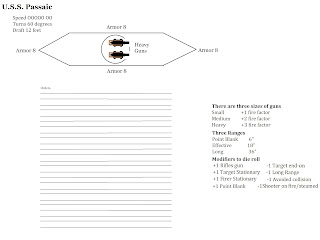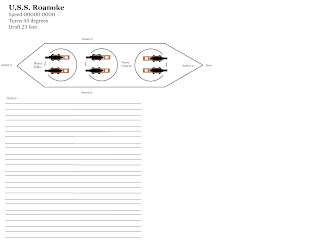These are a set of rules that I photocopied out of an old Wargames Illustrated or Miniature Wargames magazine simply ages ago, I can't find the original magazine article but I do know that Andy Callan is the author of this little gem. I take no claim or credit for these, all I can say is that they are a jolly fun set of rules that we have enjoyed for decades. Of course as the years passed I have made some modifications to the rules. If these are improvements we will set that down to happy circumstance, if they have failed the fault is mine alone. At the end of the rules I have included some worked-out ship data cards and a set of blanks templates that can be used to make new ones.
Order of Play;
Write Orders
Make ½ move
Make Turns (if any)
Make second ½ move
Make Turns (if any)
Any vessel may now fire
Shooting; roll 1d6 per gun, add fire factor and relevant modifiers needing to score higher than the targets armor to get a hit.
There are three sizes of gun;
Small +1 fire factor (up to 18lbr)
Medium +2 fire factor (over 18lb and up to 8”)
Large +3 fire factor (guns over 100lb or in excess of 8”)
There are three ranges
Point blank 3”
Effective 18”
Long 36”
There are a few modifiers to your die roll;
+1 Rifled Gun -1 target end-on
+1 Target stationary -1 shooter on fire/steam filled
+1 Firer stationary -1 Long range
+1 Point Blank Range -1 avoided a collision this turn
Effect of hits; Roll 1d6
1 = lose two speed boxes
2-3 = lose one gun
4-5 = lose lose one speed box
6 = Special Effects!
Special Effects; roll 2d6
2 Freak shot hits magazine, ship blows and sinks immediately
3 Helmsman killed, ship must continue on present course for one full turn
4 Holed and listing to port, starboard guns cannot depress enough to shoot
5 Holed and listing to starboard, port guns cannot depress enough to shoot
6 One gun shutter nearest to shooter jammed for 1d6 moves
7 Steam pipes damaged, can only increase/decease speed by one speed box
8 Stack damaged, lose two speed boxes off top speed
9 Screw/paddle jammed 1d6 turns, drift to halt
10 Steering damaged must stay on present course for 1d6 turns
11 FIRE! Roll 1d6 each turn to put out on a 5+, after 4 turns crew abandons ship
12 Boiler holed, ship drifts to halt, 1d6 on a 1-2 crew abandons ship
Movement
All movement is simultaneous and done in conformance with written orders. These orders shall take the following form; number of inches moved (up to ½ total available), any turns, remaining movement followed by any turns. An example of such would be; 5” ahead, right 45 degrees, 5 inches ahead, left 45 degrees. The maximum speed in reverse is ½ speed forward, except for Double-Ender sidewheels who may go as fast backwards as they do forwards.
Additional information will be included after the movement order such as “Increase Speed” or “Ram”. Remember that you can only increase/decrease speed by two inches per turn per turn.
Any vague or illegible orders will be allowed to be interpreted by the opposing player in the worst light possible.
Running aground.
Any vessel entering shoal waters must check for grounding; in deep shoals roll 4d6 to score higher than draft to avoid grounding, in shallow shoals roll 3d6 to avoid grounding. Once grounded a vessel rolls 1d6 each turn, needing a 6 to free itself, once freed it must move straight backward until clear of the shoal that it grounded upon.
Drifting
Any vessel whose speed has dropped to zero will drift 1” per turn in the direction of the current/tide. Each turn roll 1d6 to see if it keeps its current facing; on a one it turns 45 degrees clockwise, on a six it turns 45 degrees counter-clockwise.
Collisions and Ramming
Due to the short ranges at which these actions will take place accidental collisions and deliberate ramming are both likely to occur. Any contact between ships that does not include “Ram” as an order by the striking vessel are deemed to be accidental collisions. These will be avoided by the striking player rolling 1d6 and scoring a four or higher. If the collision is avoided the ships are moved to reflect the last-minute course change and no damage occurs, this does not count as a turn but does inflict a -1 to any shooting. If the collision is not avoided treat it like a ram (yes this can happen between friendly vessels).
Ramming occurs when the striking vessel has “Ram” written in its orders for the current turn. Ramming is defined as an event wherein the bow area of the striking vessels base enters the side area of the target ships base. End-on ramming is not possible. The vessels just grind past each other, both suffer 1 knot of speed lost and may not fire. It may be necessary to step off the movement of the ships in quarter-moves to see if a ram occurs. Thus it is incumbent on the ramming player to advise his opponent of his intention to ram before movement begins. If the conditions for an effective ramming occur consult the following chart.
Throw 1d6 modify the result as follows;
+1 Target stationary
+1 Rammer, every two boxes over 6
-1 Rammer without reinforced bow
-1 Rammer, each speed box under 4
Results;
6+
Target ship is crippled and drifts, Rammer loses two boxes of speed
4-5 Target loses 1d6 speed boxes, Rammer loses 1one speed box
2-3 No effect on either vessel
1- Rammer loses 1d6 speed boxes. No effect on target.
Sinking
If a ships speed drops below zero it will sink in 1d6+2 turns. The crew will (of course) heroically continue to serve the guns until the water closes over their vessel.
























A similar article originally appeared in Miniature Wargames, No. 14, 1984. It doesn't show the ship data cards like you have but the rules are the same.
ReplyDeletehttps://www.wfgamers.org.uk/andy-callans-articles/acw-riverine-rules
Excellent.
ReplyDeleteThanks Anton